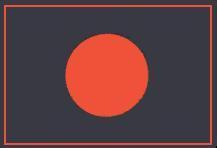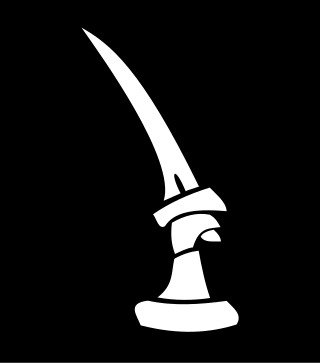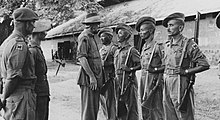
The Indian Army during World War II, a British force also referred to as the British Indian Army, began the war, in 1939, numbering just under 200,000 men. By the end of the war, it had become the largest volunteer army in history, rising to over 2.5 million men in August 1945. Serving in divisions of infantry, armour and a fledgling airborne force, they fought on three continents in Africa, Europe and Asia.
39th Indian Infantry Division was an infantry division of the Indian Army during World War II, which became a training division in 1943 after its recovery into India from Burma. The division was re-raised after independence and 39 Mountain Division is presently located in Palampur, Himachal Pradesh under XVI Corps.

The Battle of Imphal took place in the region around the city of Imphal, the capital of the state of Manipur in Northeast India from March until July 1944. Japanese armies attempted to destroy the Allied forces at Imphal and invade India, but were driven back into Burma with heavy losses. Together with the simultaneous Battle of Kohima on the road by which the encircled Allied forces at Imphal were relieved, the battle was the turning point of the Burma campaign, part of the South-East Asian theatre of World War II. The Japanese defeat at Kohima and Imphal was the largest up until that time, with many of the Japanese deaths resulting from starvation, disease and exhaustion suffered during their retreat. According to voting in a contest run by the British National Army Museum, the Battle of Imphal was bestowed as Britain's Greatest Battle in 2013.

The British Commonwealth Occupation Force (BCOF) was the British Commonwealth taskforce consisting of Australian, British, Indian and New Zealand military forces in occupied Japan, from 1946 until the end of occupation in 1952.
The 10th Princess Mary's Own Gurkha Rifles,, was originally a rifle regiment of the British Indian Army. The regiment was formed in 1890, taking its lineage from a police unit and over the course of its existence it had a number of changes in designation and composition. It took part in a number of campaigns on the Indian frontiers during the 19th and early 20th centuries, before fighting in the First World War, the Third Anglo-Afghan War and the Second World War. Following India's independence in 1947, the regiment was one of four Gurkha regiments to be transferred to the British Army. In the 1960s it was active in the Malayan Emergency and Indonesian Confrontation. It was amalgamated with the other three British Gurkha regiments to form the Royal Gurkha Rifles in 1994.

The 7th Gurkha Rifles was a rifle regiment of the British Indian Army, before being transferred to the British Army, following India's independence in 1947 and after 1959 designated as the 7th Duke of Edinburgh's Own Gurkha Rifles.

The 5th Indian Infantry Division was an infantry division of the Indian Army during World War II that fought in several theatres of war and was nicknamed the "Ball of Fire". It was one of the few Allied divisions to fight against three different armies - the Italian, German and Japanese armies.

The concurrent Battle of Meiktila and Battle of Mandalay were decisive engagements near the end of the Burma campaign during World War II. Collectively, they are sometimes referred to as the Battle of Central Burma. Despite logistical difficulties, the Allies were able to deploy large armoured and mechanised forces in Central Burma, and also possessed air supremacy. Most of the Japanese forces in Burma were destroyed during the battles, allowing the Allies to later recapture the capital, Rangoon, and reoccupy most of the country with little organised opposition.

The 19th Indian Infantry Division was an infantry division of the Indian Army during World War II, and played a prominent part in the final part of the Burma Campaign.

The 20th Indian Infantry Division was an infantry division of the Indian Army in the Second World War, formed in India, and took part in the Burma Campaign during the Second World War. After the war, the bulk of the division was deployed to French Indochina to oversee the handover from Japanese to French rule. For nearly all is operational life the division was commanded by Major-General Douglas Gracey. The division's history is subject of open source and historical records research, including the Order of Battle, on an open access, WW2 history website and subject of updates in August 2021

The 7th Infantry Division is a war-formed infantry division, part of the British Indian Army that saw service in the Burma Campaign.

The Battle of Pakokku and Irrawaddy River operations were a series of battles fought between the British Indian Army and the Imperial Japanese Army and allied forces over the successful Allied Burma campaign on the China Burma India Theater during World War II. The battles and operations were instrumental in facilitating the eventual capture of Rangoon in summer 1945.

The 23rd Indian Infantry Division was an infantry division of the Indian Army during World War II. It fought in the Burma Campaign. It was then reformed as a division of the independent Indian Army in 1959.

The 25th Indian Infantry Division was an infantry division of the Indian Army during World War II which fought in the Burma Campaign. It was re-raised within the post-independence Indian Army in 1948.
The 8th (Lucknow) Division was a formation of the British Indian Army's Northern Army that was first formed as a result of the Kitchener reforms of the Indian Army in 1903. The Division remained in India on internal security duties during World War I, though the 8th (Lucknow) Cavalry Brigade was transferred to the 1st Indian Cavalry Division and served in France on the Western Front, and the 22nd Lucknow Infantry Brigade served as part of the 11th Indian Division in Egypt.

Major General David Tennant Cowan,, also known as "Punch" Cowan, was an officer in the British Army and British Indian Army during the First and Second World Wars. He led the 17th Indian Infantry Division during almost the entire Burma campaign.
The Burma Corps ('Burcorps') was an Army Corps of the Indian Army during the Second World War. It was formed in Prome, Burma, on 19 March 1942, took part in the retreat through Burma, and was disbanded on arrival in India in May 1942.
The 48th Infantry Brigade, was raised as the 48 Indian Infantry Brigade, in October 1941, at Secunderabad, India. After an initial tenure with 19th Indian Infantry Division, it was transferred to the 17th Indian Infantry Division. In World War II it participated in the Burma campaign and in April 1942 was attached to 1st Burma Division. After the war the brigade returned to India as an independent brigade, and was located at Dhond in August 1947. After India gained Independence in 1947, 48 Indian Infantry Brigade was re-designated as 48 Infantry Brigade. Since then 48 infantry brigade has seen action Goa in 1961, as part of 17 Infantry Division; in the 1962 War in Kameng Frontier Division, Arunachal Pradesh, as part of 4th Infantry Division; and in the 1971 war, as part of 7th Infantry Division. Since the 1970s, 48 Infantry Brigade has been located in Ferozpur, Punjab, as part of 7 Infantry Division.
The 63rd Indian Infantry Brigade was an infantry brigade formation of the Indian Army during World War II. It was formed in January 1942, at Jhansi in India and was assigned to the 23rd Indian Infantry Division and served in the Burma Campaign. In March 1942, it was reassigned to the 17th Indian Infantry Division with whom it remained for the rest of the war apart from in May 1942, when it was attached to the 39th Indian Infantry Division.
The 268th Indian Infantry Brigade is an infantry formation of the Indian Army, previously of the British Indian Army.

















